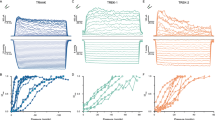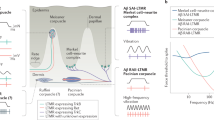Abstract
THE terms action-potential and impulse are often considered interchangeable1. But while action potentials would include impulses together with graded potentials, it may be useful to define impulses as all or none potential changes with a constant amplitude and shape unaffected by changes in the strength or quality of the stimulus1. Impulses, so defined, are usually associated with conduction in nerve and muscle but are also found in plants2, protozoans3, and may be common in epithelia of coelenterates but are only definitely established in some hydrozoan jellyfish4,5. The first example that I know of impulses from non-nervous and non-muscular tissue in a vertebrate is described here from the skin of clawed toad (Xenopuslaevis) tadpoles.
This is a preview of subscription content, access via your institution
Access options
Subscribe to this journal
Receive 51 print issues and online access
$199.00 per year
only $3.90 per issue
Buy this article
- Purchase on Springer Link
- Instant access to full article PDF
Prices may be subject to local taxes which are calculated during checkout
Similar content being viewed by others
References
Hodgkin, A. L., The Conduction of the Nervous Impulse (Liverpool University Press, 1964).
Sibaoka, T., Symp. Soc. Exp. Biol., 20, 49 (1966).
Eckert, R. O., and Sibaoka, T., J. Gen. Physiol., 52, 258 (1968).
Mackie, G. O., Amer. Zool., 5, 439 (1965).
Mackie, G. O., and Passano, L. M., J. Gen. Physiol., 52, 600 (1968).
Nieukoop, P. D., and Faber, J., Normal Table of Xenopus Laevis (Daudin) (North-Holland Publishing Co., Amsterdam, 1956).
Assheton, R., Quart. J. Micros. Sci., 38, 465 (1896).
Cameron, J. A., J. Morphol., 60, 279 (1936).
Pflugfelder, O., and Schubert, G., Z. Zellforsch., 67, 96 (1965).
Whittenbury, G., J. Gen. Physiol., 47, 795 (1964).
Muntz, L., dissertation, Univ. Bristol (1964).
Wintrebert, P., CR Acad. Sci., 171, 680 (1920).
Sheridan, J. D., J. Cell. Biol., 31, C1 (1966).
Loewenstein, W. R., Ann. NY Acad. Sci., 137, 441 (1966).
Potter, D. D., Furshpan, E. J., and Lennox, E. S., Proc. US Nat. Acad. Sci., 55, 328 (1966).
Parker, G. H., The Elementary Nervous System (Lippincott, Philadelphia and London, 1919).
Wintrebert, P., CR Acad. Sci., 171, 408 (1920).
Author information
Authors and Affiliations
Rights and permissions
About this article
Cite this article
ROBERTS, A. Conducted Impulses in the Skin of Young Tadpoles. Nature 222, 1265–1266 (1969). https://doi.org/10.1038/2221265a0
Received:
Revised:
Issue Date:
DOI: https://doi.org/10.1038/2221265a0
This article is cited by
-
Contribution to the Whole (H). Can Squids Show us Anything that We did not know Already?
Biology & Philosophy (2006)
-
Coupling of gap junctions by induction of impulse conductivity in cultured epithelium of newt embryo (Cynops orientalis)
Cell and Tissue Research (1985)
-
The development of a dual touch sensory system in embryos of the amphibianXenopus laevis
Journal of Comparative Physiology (1974)
-
Correlates of electrical activity inXenopus laevis embryos
Journal of Comparative Physiology (1973)
-
The properties and propagation of a cardiac-like impulse in the skin of young tadpoles
Zeitschrift f�r Vergleichende Physiologie (1971)
Comments
By submitting a comment you agree to abide by our Terms and Community Guidelines. If you find something abusive or that does not comply with our terms or guidelines please flag it as inappropriate.



